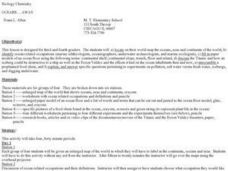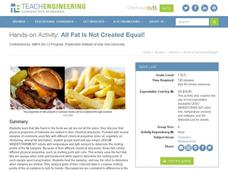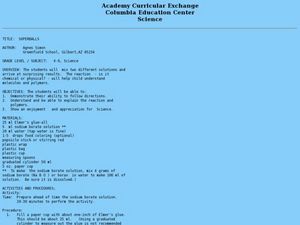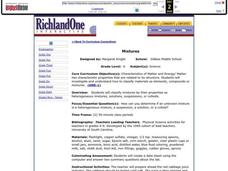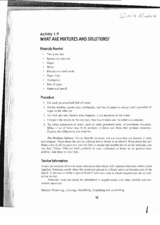Curated OER
Breaking News English: British Food Best in the World
In this English worksheet, students read "British Food Best in the World," and then respond to 47 fill in the blank, 7 short answer, 20 matching, and 8 true or false questions about the selection.
Curated OER
Does Dye Die? Foreign Chemicals in Our Environment
Students conduct an experiment to observe photolysis in the lab. In this chemistry instructional activity, students explain the mechanism behind photolysis. They test the impact of a non-toxic marker to plant metabolism.
Curated OER
How Sweet It is! A Colorful Sugar Solution Density Column
Learners examine the affect of density. Using a graduated cylinder and equally prepared volumes of sugar-water solutions and food color, students observe a sugar rainbow. They discover that the greater the amount of sugar in the...
American Chemical Society
Liquids - Clearly Unique
Bring chemistry to life for scholars as they perform two tests to examine the unique properties of three liquids. Classroom investigators make observations, develop basic lab skills, and follow step-by-step instructions to compare water,...
Curated OER
Galileo's Thermometer: Measuring the Density of Various Unknown Liquids
Sprouting scientists explore the concept of density by making mass and volume measurements for five different liquids. From these measurements, they calculate densities. They apply their learning to explain Galileo's thermometer works...
Curated OER
Let's Make a Tubeworm!
Pupils discuss deep-sea chemosynthetic communities then create a poster of a three-dimensional tubeworm. In this creative lesson students create their own tubeworm and write a written report on it.
Curated OER
Cooking Up an Explanation
Students pose scientific questions about food items and research their explanations. They then create recipe cards with the answers and present their findings in a cooking show format.
Curated OER
Water
Students conduct a series of investigations on the unique properties of water. In this general science activity, students explain what causes water's surface tension. They explain the different stages in the water cycle.
Curated OER
Diffusion of Molecules
Students study the process for diffusion of molecules. In this chemistry lesson, students understand molecular movement, develop skills for a chemistry investigation, develop skills in making hypotheses, develop observational skills, and...
Curated OER
Diffusion of Molecules
Students conduct a series of experiments to observe factors that impact molecular movement. For this molecular chemistry lesson, students drop food coloring in water with different properties (hot, with ice, with alcohol) and observe how...
Curated OER
You Are What You Eat (Grades 5-8)
Students gain an enhanced understanding of the relationship between proper nutrition and good health. Through use of video, hands-on activities and interaction, students measure energy in food, and recognize sources of vitamins and...
Curated OER
Polymer Lesson Plans
Try these hands on lessons dealing with polymers to get students thinking chemistry and the structure of molecules.
Curated OER
Oceans Away
Students explore oceans. In this science lesson plan, students locate oceans, seas and continents of the world, identify ocean-related occupations, and complete activities pertaining to food chains as well as pollution.
Curated OER
Esters: The Secret of Natural and Synthetic Fragrances
Students investigate esters, make an ester and detect esters in natural foods and plants. In this esters lesson plan, students detect smells of hidden objects, produce an ester using peas, brown sugar and apple and demonstrate how to...
Curated OER
States of Matter
Students discuss a given set of questions based on Chemistry and matter and review a glossary of terms. They conduct experiments on each state of matter: "Dry ice and water, Dry ice and soap and Dry ice and Isopropyl Alcohol." and...
Curated OER
You Are What You Eat!
Students calculate the calorie content of food. In this chemistry lesson, students plan a healthy meal based on RDA. They devise an exercise to burn extra calories.
Teach Engineering
All Fats Are Not Created Equal
Apply robotics to connect physical properties to chemical properties. Future engineers use robots to determine the melting points of various fats and oils. The robots can do this by measuring the translucency of the fats as they heat up.
Cornell University
Polymers: Making Silly Putty
Putty is proof that learning can be fun! Share the wonderful world of polymers with your class through an experiment. Young scientists create their own silly putty, then examine its properties.
Curated OER
Fred the Fish -- A River Ran Wild
Students apply cause and effect relationships to water pollution in a stream. For this pollution lesson students recognize the importance of clean water in their daily lives. Students accompany "Fred the Fish" as he travels down stream....
Curated OER
Sweet Science: How Sugar Molecules are Manipulated in Candy Making
Students investigate how heat affect sugar solutions. In this science instructional activity, students compare the sweetness of different types of sugars. They research the development of sugar and create a timeline.
Curated OER
Health: Basic Minerals
Students examine minerals as food nutrients and discover their importance as food sources in the diet. Among the learning options are completing worksheets, creating recipes, making billboards, and actually preparing some recipes rich...
Curated OER
Superballs
Students mix two different solutions to become more familiar with molecules and polymers. In this chemistry lesson, students decide whether or not the reaction between two solutions is chemical or physical. Students then observe the...
Curated OER
Mixtures
Sixth graders experiment with mixtures. In this chemistry lesson plan, 6th graders determine which mixtures are considered heterogeneous, a suspension, a solution or a colloid. Students create a data sheet of what they discover.
Curated OER
What Are Mixtures And Solutions?
Students explore mixtures and solutions. In this chemistry lesson plan, students will add different ingredients to jars in order to classify them as mixtures or solutions. There is also a nail balancing activity that can be done at...
Other popular searches
- 4th Grade Food Chemistry
- Food Chemistry Pdf
- Food Chemistry Quiz
- Food Chemistry Pancakes
- Food Chemistry Protein
- Food Chemistry Detection
- Food Chemistry Mcq
- Food Chemistry Pd
- Food Chemistry Cakes
- Food Chemistry Protien
- Food Chemistry Mc
- Food Chemistry Pancackes












